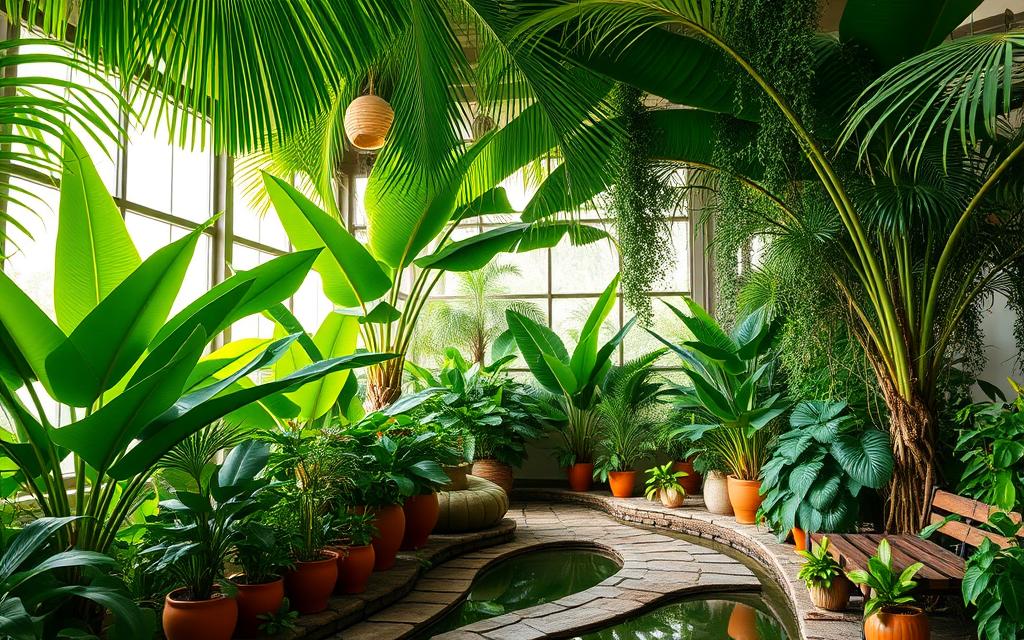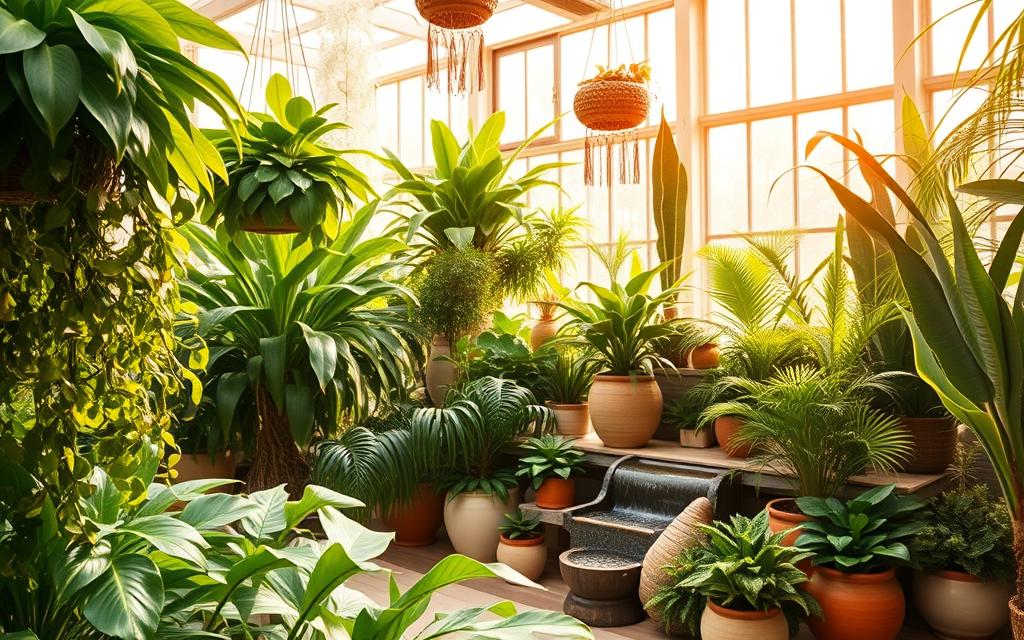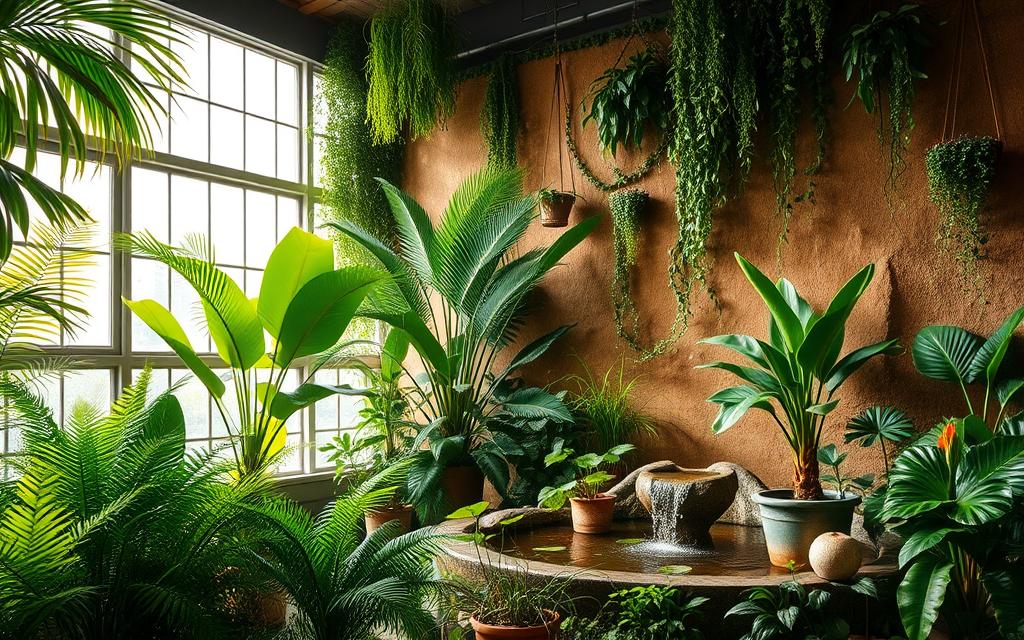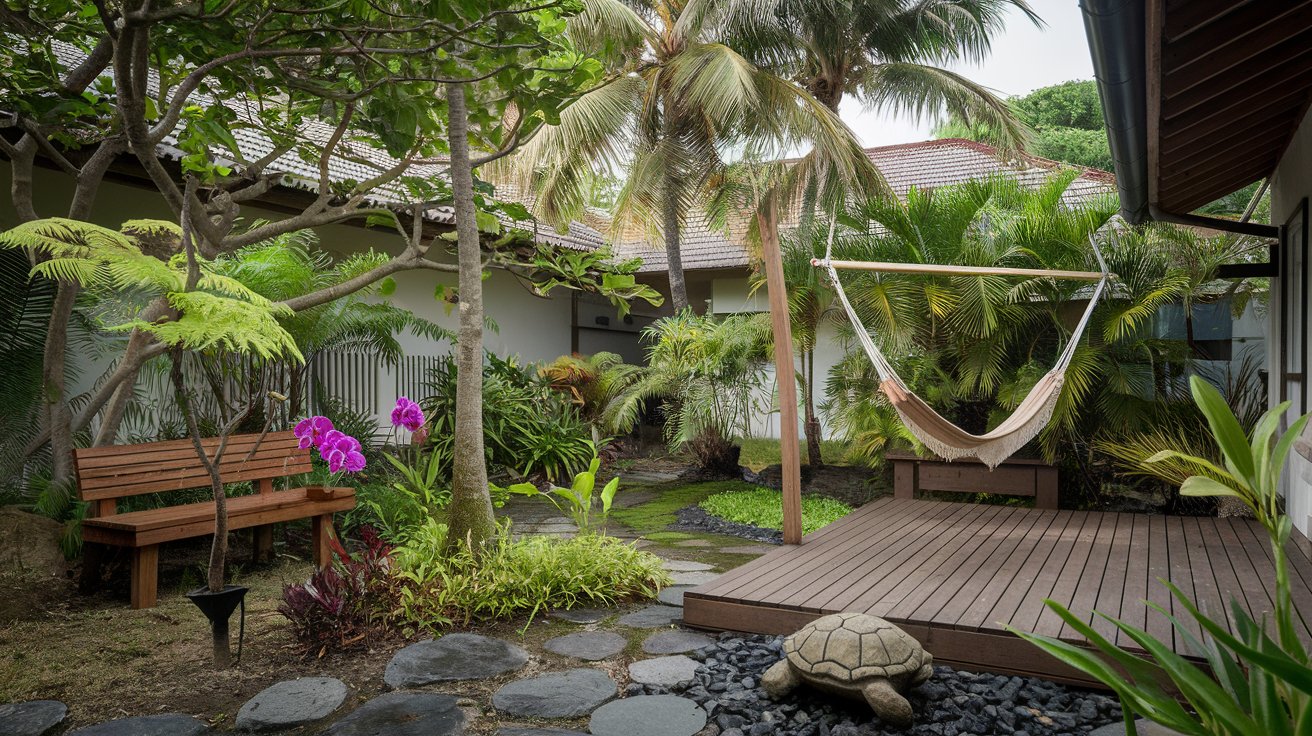Table of Contents

Did you know indoor plants can cut stress by up to 37% and make your air cleaner? Creating a tropical home garden is more than looks. It’s about turning your home into a lively, natural haven that connects you to the outdoors.
I love plants, and tropical landscaping is a great way to add exotic beauty and calm to your home. By picking the right plants and setting up the perfect spot, you can make an indoor tropical paradise. It’s like having your own personal retreat.
My adventure in tropical garden design showed me anyone can make a lush, green space. It doesn’t matter if you live in a small place or a big one. The key is to know what plants need, create the right conditions, and choose beautiful tropical plants.
Key Takeaways
- Indoor tropical gardens reduce stress and improve air quality
- Tropical landscaping can transform any living space
- No gardening experience is required to create a stunning indoor garden
- Proper plant selection is crucial for success
- Creating the right environment is key to maintaining tropical plants
Understanding the Essentials of Indoor Tropical Gardens
To create a successful indoor tropical garden, you need to focus on specific conditions. As a passionate gardener, I’ve found that it’s not just about picking pretty plants. It’s about making their natural home in your house.

When designing an indoor tropical garden, following sustainable gardening principles is key. These plants need special care and the right environment to grow well in places they don’t naturally live.
Climate Control Requirements
Tropical plants love warm temperatures, between 60-85°F. Here are some tips to keep your plants happy:
- Keep plants away from cold drafts
- Use heating mats for root temperature control
- Keep room temperatures steady
Lighting Considerations
Lighting is crucial for tropical plants. They need bright, indirect sunlight. If natural light is not enough, try these options:
- LED grow lights
- Fluorescent full-spectrum bulbs
- Place near east or west-facing windows
Humidity Management
Tropical plants love high humidity. Sustainable gardening techniques can help you achieve the right moisture:
- Use humidity trays with pebbles and water
- Group plants to increase moisture in the air
- Mist plants with filtered water regularly
Understanding these key elements will help you turn your indoor space into a lush, thriving tropical paradise.
Selecting the Perfect Tropical Plants for Indoor Growth
Creating an indoor tropical garden is all about picking the right plants. I’ll show you how to choose the most beautiful and easy-to-grow tropical species. They will turn your home into a lush paradise.

When picking plants for your indoor garden, focus on three main types. These will add life and character to your space.
Large Tropical Foliage Plants
Large tropical foliage plants are dramatic and impressive. They make a big impact in any room. Here are my top picks:
- Monstera deliciosa with its iconic split leaves
- Bird of Paradise for dramatic vertical presence
- Rubber plant with glossy, deep green leaves
- Fiddle leaf fig for architectural elegance
Flowering Tropical Species
Flowering tropical species add color and beauty to your garden. Here are some great options:
- Orchids for delicate, long-lasting blooms
- Hibiscus with its vibrant, dinner-plate-sized flowers
- Bromeliads offering unique color patterns
Exotic Fruit-Bearing Plants
Imagine growing your own tropical fruit trees indoors! Here are some great choices:
| Plant | Fruit Yield | Care Difficulty |
|---|---|---|
| Dwarf Meyer Lemon | Sweet lemons | Moderate |
| Indoor Pineapple Plant | Small pineapples | Challenging |
| Dwarf Fig Tree | Fresh figs | Easy |
When choosing plants for your indoor garden, think about your home’s conditions. Light, humidity, and temperature matter. Each plant has its own needs for success in your space.
Maintaining Your Indoor Tropical Paradise
Creating a thriving indoor tropical garden needs care and smart strategies. Your backyard oasis can be easy to maintain. With the right approach, you can enjoy lush tropical vibes without much work.
Understanding your plants’ needs is key. Here are some essential maintenance tips to help your garden thrive.
Watering Schedule and Techniques
Proper watering is crucial for tropical plants. Here’s what I recommend:
- Check soil moisture before watering
- Use room temperature water
- Ensure adequate drainage
- Water deeply but infrequently
Fertilization Guidelines
Nutrient management is vital for a vibrant tropical garden. Seasonal fertilization keeps plants healthy and robust.
- Use balanced liquid fertilizers
- Apply nutrients during active growth periods
- Reduce fertilization during winter months
- Follow specific plant requirements
Pest Control Methods
Protecting your tropical plants from pests is essential. Natural solutions are best for a healthy indoor ecosystem:
- Regularly inspect plant leaves
- Use neem oil for organic pest control
- Introduce beneficial insects
- Isolate infected plants immediately
By following these maintenance tips, you’ll turn your indoor space into a stunning tropical retreat. It will bring joy and serenity to your home.
Incorporating Tropical Design Elements and Accessories
To make your home feel like a tropical getaway, start with design and accessories. Natural materials like bamboo and rattan can turn any room into a lively tropical spot. These elements add warmth and texture, making your space feel real and welcoming.
Color is important in tropical design. Use bright, lively colors to bring the energy of the tropics inside. Try rich greens, deep blues, and warm oranges in throw pillows, wall art, and ceramics. Adding tropical landscapes or botanical prints can make your space feel more immersive.
Water features bring the rainforest vibe indoors. Small fountains or wall-mounted water elements can create a calming atmosphere. Soft lighting and warm-toned bulbs or decorative lanterns enhance the tropical feel, turning your garden into a peaceful retreat.
Choosing the right accessories is crucial for a cohesive tropical look. Use woven textiles, carved wooden sculptures, and ceramic planters with unique textures. Layering these elements creates a space that feels like a lush, tropical paradise.
FAQ
How difficult is it to create an indoor tropical garden?
Creating an indoor tropical garden is easier than you think! With the right knowledge, anyone can make their space lush and tropical. Understanding tropical plants’ needs, like humidity and light, is key. Start with a few easy plants and grow your collection as you learn.
What are the best tropical plants for beginners?
Beginners should start with plants like Monstera deliciosa, Snake Plant, or Pothos. These plants are easy to care for and can handle indoor conditions. They grow well in indirect light and can forgive occasional neglect, making them great for beginners.
How can I maintain proper humidity for tropical plants?
Keeping humidity right is important for tropical plants. Use a humidity tray, mist plants, or group them together. Bathrooms and kitchens are naturally humid, perfect for tropical plants. Keep humidity between 50-60% for most plants.
What lighting conditions do tropical plants need?
Tropical plants love bright, indirect light. Place them near east or west windows for filtered sunlight. Avoid direct sunlight that can burn their leaves. If natural light is scarce, LED grow lights are a good substitute.
How often should I water my tropical indoor plants?
Watering varies by plant, but check soil moisture first. Stick your finger into the soil – if it’s dry, water. Most plants prefer moist soil but avoid waterlogged soil. Use pots with holes and a good potting mix. Water less in winter when plants grow slower.
Can I grow tropical fruit trees indoors?
Yes, you can grow tropical fruit trees indoors! Dwarf varieties like Meyer lemons and fig trees work well. They need plenty of light, consistent moisture, and occasional fertilizer. This will help them grow and produce fruit.
How do I prevent pest problems in my tropical indoor garden?
Preventing pests is key for a healthy garden. Regularly check your plants for insects and keep them clean. Use natural pest control like neem oil. Quarantine new plants and avoid overwatering to prevent pests like fungus gnats.

